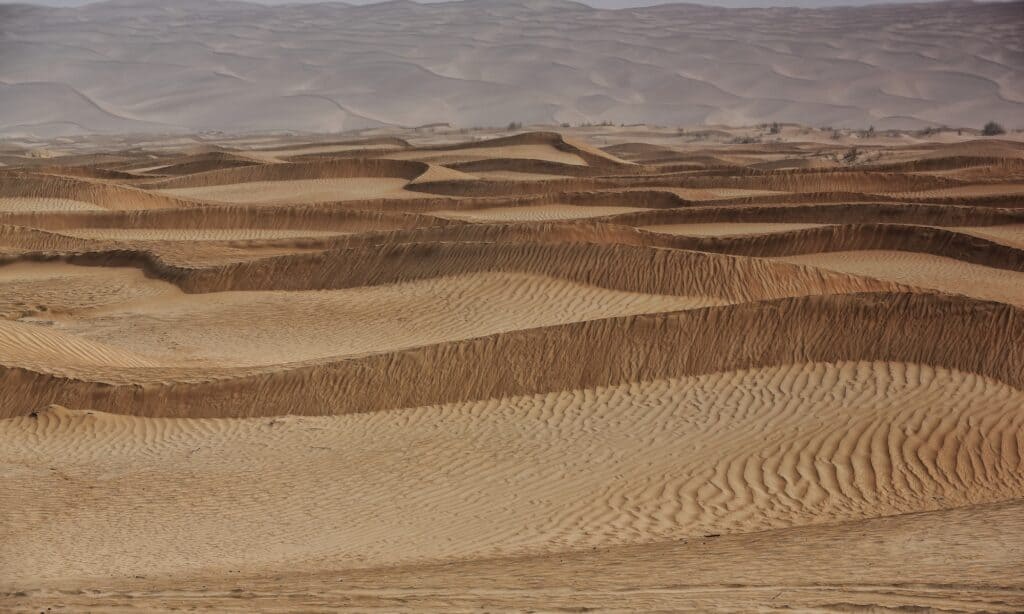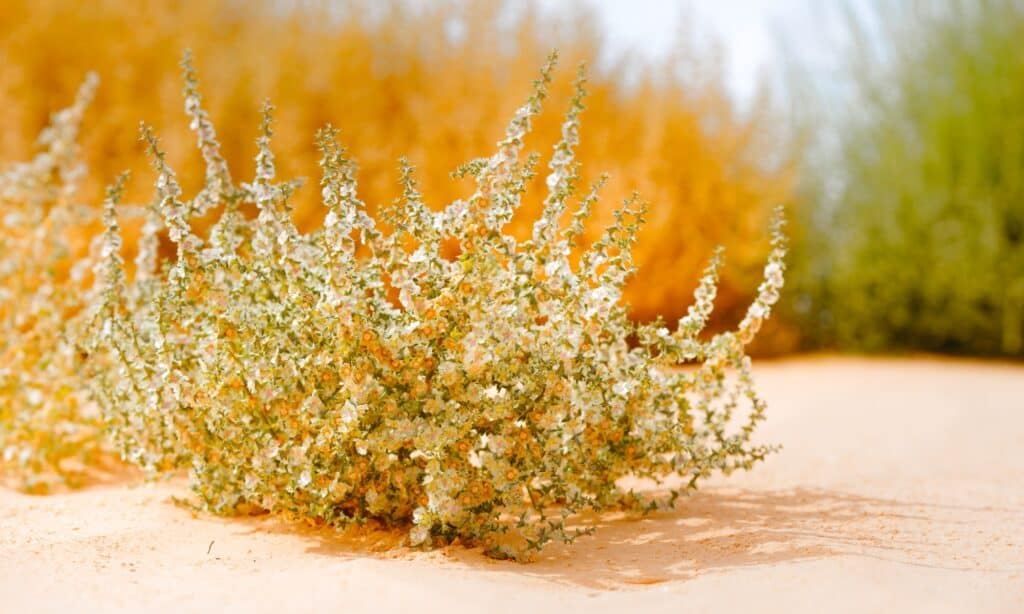The Taklamakan Desert is a great desert located in China’s Xinjiang province. It is one of the largest sandy deserts in the world and the largest desert in China. It is widely reputed for its shifting dunes and the complete bareness of its landscape. The desert is encircled by tall mountains on all sides. This explains why the area is so deprived of moisture. Due to the aridity of this region, almost the entire region is devoid of plant cover. Here’s all you need to know about the Taklamakan Desert.
Taklamakan Desert: Location and Name
The origin and meaning of the name “Taklamakan” have remained controversial over the years. Experts agree that the word “makan” is of Persian origin and translates as “place.” However, the meaning of “Takla” is unclear. The most common translations given for this word include “abandon,” “leave behind,” or “relinquish.” Based on this translation, the name of the desert would translate loosely as “abandoned place.” Some experts have also suggested the name “the place of ruins” for this desert.
More commonly, the desert is referred to by its nickname, such as “Sea of Death” or “Place of No Return.” These nicknames refer to legends that describe the Taklamakan as “a place one can get into but will never get out of” due to the brutal and dangerous nature of the desert’s climate.
Located in the southwestern Xinjiang province in Northwest China, the Taklamakan desert is flanked by mountain ranges on all sides. The southern boundary of this desert is the Kunlun Mountain, while it has the Tian Shan Mountain Range to its north and the Pamir Mountains to the west. The Taklamakan also shares a boundary with the Gobi Desert on its eastern flank.
Taklamakan Desert: Size

The Taklamakan is considered the second-largest shifting sand desert in the world.
©iStock.com/rweisswald
With a land area of about 130,000 square miles (337,000 square kilometers), the Taklamakan Desert is the largest in China. It is just slightly smaller than the entire country of Germany. The desert is about 600 miles long from west to east and has a maximum width of about 260 miles (420 km).
The Taklamakan Desert is part of the Tarim Basin, a 620 miles long basin, one of the largest basins in Northwest China. The Taklamakan used to be an important part of the Silk Road, an ancient Asian trade route active until the mid-15th century. Two branches of this network of trade routes crossed this desert’s northern and southern edges.
Due to its massive size, the Taklamakan is considered the second-largest shifting sand desert in the world. Up to 85% of this desert is made of shifting dunes. It also ranks 17th on the list of the largest deserts in the world.
Taklamakan Desert: Climate
The Taklamakan has a predominantly continental cold desert climate. This is mainly due to the unique location of this desert in the shadow of the Himalayan mountains. Its extreme inland position further contributes to the aridity of this desert as it is significantly far from any open body of water.
The unique location of this desert also accounts for the wide variations in the daily temperatures. The maximum annual temperature in this desert is about 70 °F (39 °C). During winter, the temperature may fall as low as −4 °F (−20 °C) due to the desert’s proximity to the cold Siberian air mass. Summer temperatures often reach a maximum of about 104 °F (40 °C ).
The sea of death receives extremely low levels of precipitation. Rainfall in the eastern part of this desert is as low as 0.4 inches (10 mm) annually. The west receives more moisture (about 1.5inches/38), which is also significantly low. The desert has been known to experience winter snowfall in the past.
Taklamakan Desert: Geography And Physical Features

Taklamakan desert is an extremely barren landscape.
©Pravit / CC BY-SA 4.0 – License
This desert’s two main landscape features are the shifting dunes and the dry river valleys. Two of the most prominent river valleys are Hotan and Yarkand. They are completely dry and lined with a thick layer of salt. As the nickname suggests, Taklamakan is an extremely barren landscape. It is one of the few terrestrial habitats in the world with such a large patch of land devoid of significant macroscopic life.
The desert is also interspersed with small mountain ranges formed as far back as the Cenozoic era (up to 65 million years ago). These mountains are more prominent in the western part of Taklamakan. Some major mountains include the arc-shaped Mazartag Mountains and the Rosstagh Mountain (also known as Tokhtakaz Mountain).
Another interesting landscape feature of this desert is the Turpan Depression. Located in the northeastern part of the desert, the land slumps to an elevation of 154 m below sea level in this area. This makes the depression one of the lowest locations on earth that isn’t underwater.
Taklamakan Desert: Plant and Animal Life
Plant and animal life is sparse in the Taklamakan Desert. This is due to the temperature extremes and high aridity of this desert. The summers are very hot, and the winters can also get extremely cold. Only highly resilient plants and animals can survive in this desert.
Plant Life

Saltworts may grow in the Taklamakan desert.
©iStock.com/Nature, food, landscape, travel
The Taklamakan Desert is one of the few locations on earth completely devoid of plant cover for a very long distance. However, you may still encounter some highly resilient plant species, especially in depressions where the groundwater is not too far from the surface (within 10 to 15 feet). In thin thickets of the desert, plants like tamarisk, nitre bushes, and reeds may grow.
However, even in places like this, the thick strata of moving sands make it difficult for more vegetation to grow and spread. The edges of the desert, especially where the desert meets the river valleys and deltas, tend to support more plant growth because the groundwater there is closer to the surface. In addition to desert plants, many other plant species, such as camel thorn, oleaster, Turanga poplar, and saltworts, may grow here too.
Animal Life

Rabbits can live in the dunes of the desert.
©LNbjors/Shutterstock.com
Due to the widespread absence of vegetation, the animal life of the Taklamakan is extremely sparse. The few animals that live here favor the river valleys and deltas on the edges of the desert, where water and vegetation may appear occasionally. Gazelles and wild boars may live on the sparse vegetation in these areas. Wolves and foxes are the major carnivores that call this desert home. In the past, the desert used to have a small population of tigers, but they have since gone extinct locally.
Some animals that are also in this desert region but are rarely seen include the Siberian deer and wild camel. There’s a camel reserve located in the eastern part of Taklamakan. Most of China’s remaining wild camels (about 650) are found here.
The desert also supports a small population of critters such as rabbits, jerboas, field mice, and gerbils living in the dunes. The long-eared hedgehog, which lives on a predominantly insectivorous diet, is also common. The bird species of the Taklamakan Desert include the Tarim Jay and tufted larks.
Up Next
The photo featured at the top of this post is © iStock.com/rweisswald
Sources
- Beautiful World, Available here: https://www.beautifulworld.com/asia/china/taklamakan-desert/
- One Earth, Available here: https://www.oneearth.org/ecoregions/taklimakan-desert/
Thank you for reading! Have some feedback for us? Contact the AZ Animals editorial team.






